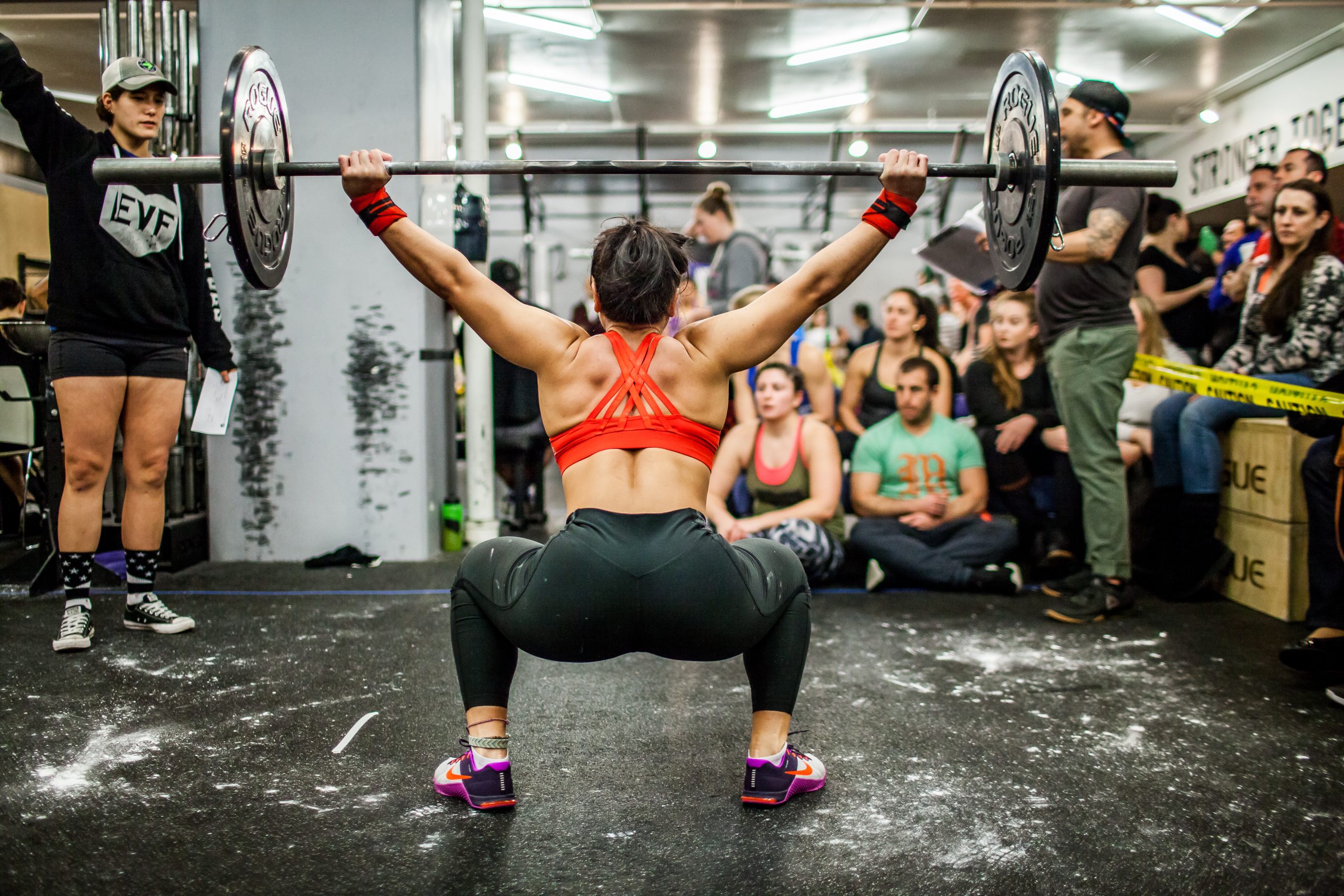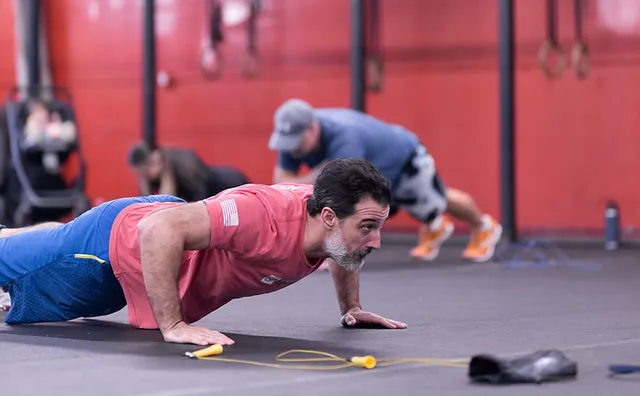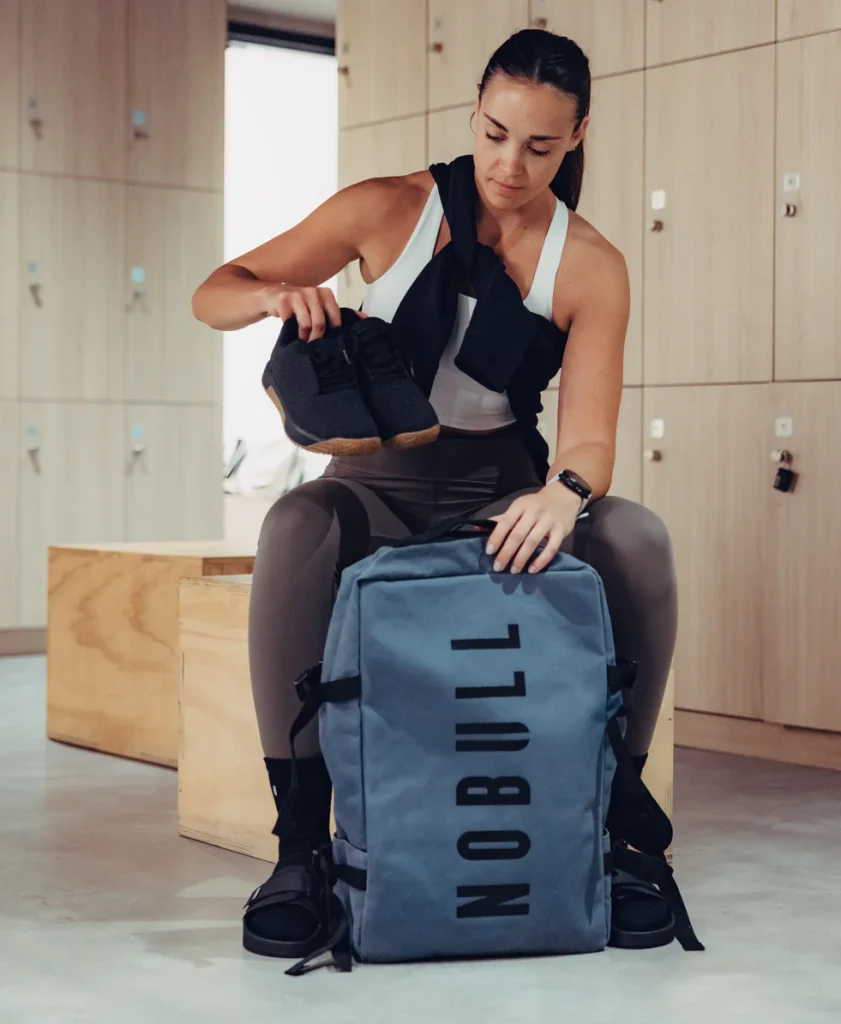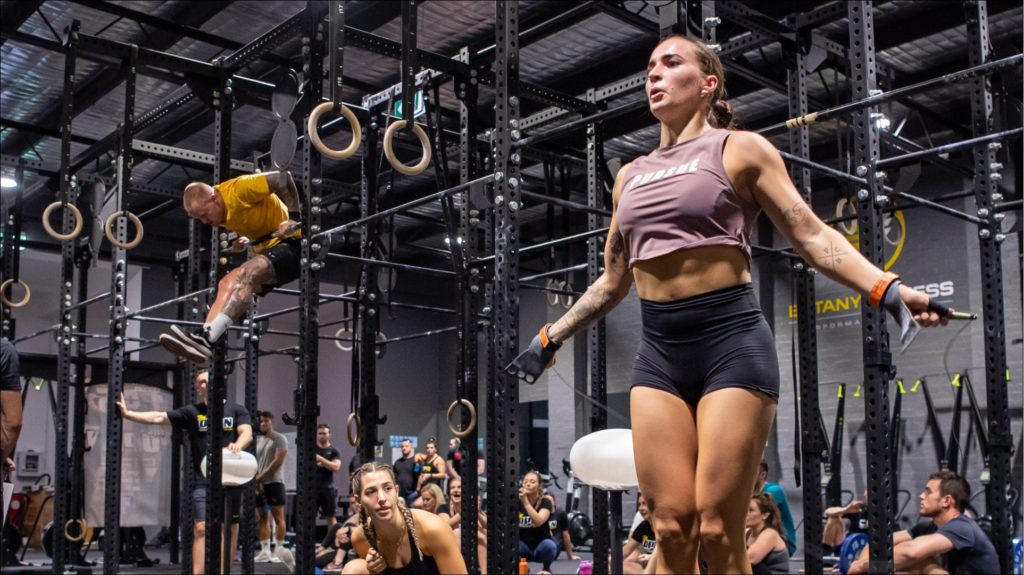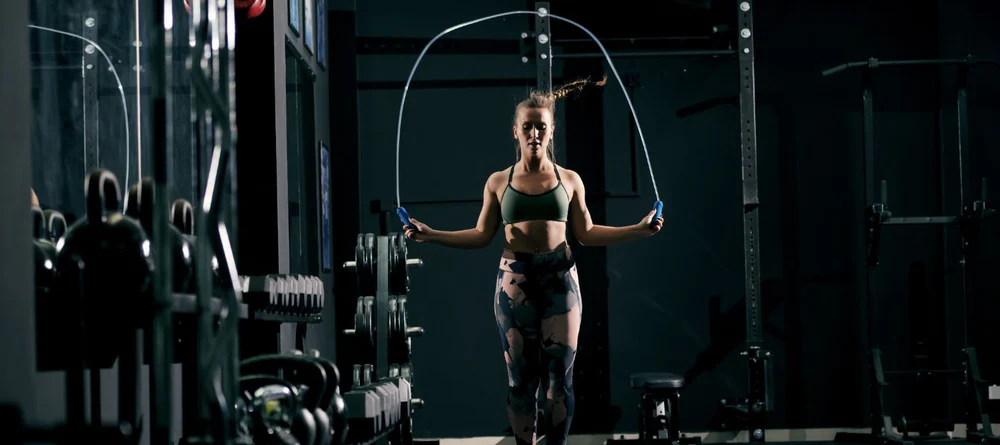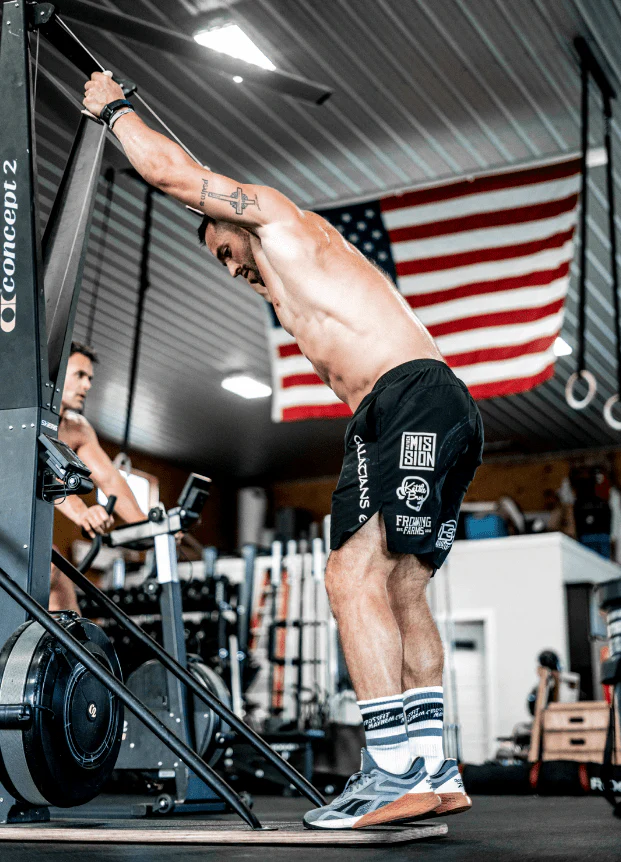Everything You Need to Know About CrossFit: A Comprehensive Guide (2024) | CrossFit Training Tips
We independently test and/or review everything we recommend. When you buy through our links, we may earn a commission. Your support helps fund our testing and review efforts and allows us to grow and expand, bringing you even more trusted recommendations.
CrossFit’s popularity is actually turning out to be pretty cool. It has captured the attention of people worldwide. Only over the last two decades really, has CrossFit proven itself to be an extremely reliable fitness system.
But Why? Why in the world is CrossFit all of the sudden the one everybody knows?
Is it CrossFit’s unique approach to physical conditioning? Is it more powerful than we realize? Isn’t it just another fad or workout regimen among the masses?
Ultimately, it does depend on what your goals are in health and fitness. So then what are peoples’ health and fitness goals if they are so often turning to CrossFit?
One thing is for sure, CrossFit’s wholehearted philosophy integrates high-intensity training with functional movements. And that is the foundation in a nut shell, but we must dig deeper…
Whether you’re curious about what it has to offer, uncertain if you can endure it, or baffled by the sight of individuals willingly flipping tractor tires, the following information will provide a thorough breakdown of many of CrossFit’s ins and outs. Things like: why people are drawn to it, and what you can expect if you decide to join.
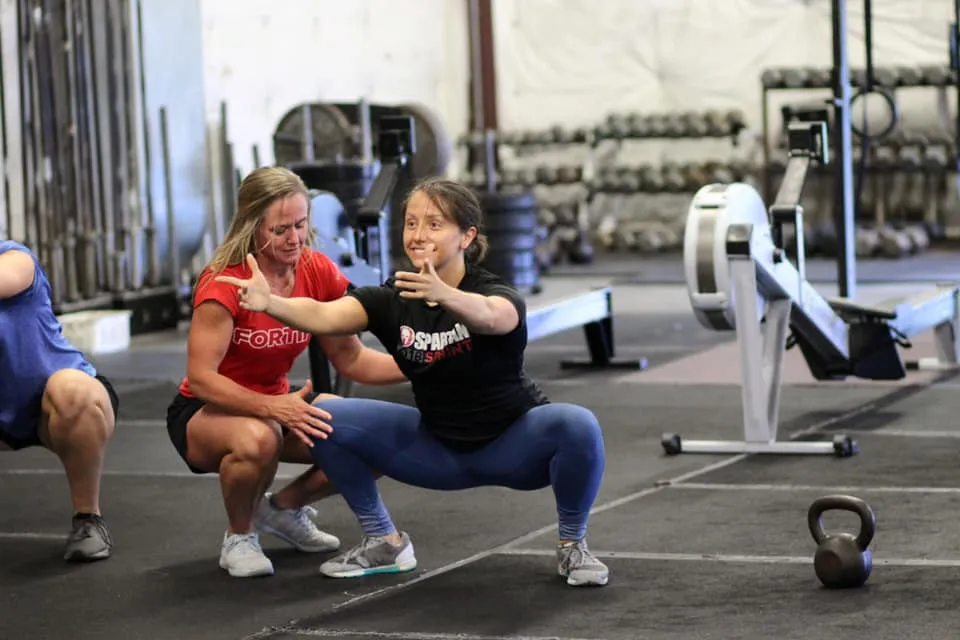
AN INTRODUCTION TO CROSSFIT
I’m going to shoot you straight, CrossFit is not for the faint of heart, at least initially. However, so many people, when they think of CrossFit, they think of super athletic, buff, ripped chicks and dudes, but it’s not just reserved for elite athletes.
It’s a versatile fitness program. Participants get to engage in a variety of exercises, from swinging kettlebells to performing burpees and Olympic lifts, but at a scaled approach if necessary. My experience has shown me that CrossFit WILL push you to your physical limits, but also that the exercises are not unreasonable to accomplish when scaled.
What also distinguishes CrossFit from other workout programs is its community-driven environment and emphasis on functional fitness.
From its inception to the reasons behind its widespread popularity, this guide offers a deep dive into CrossFit’s structure and appeal.
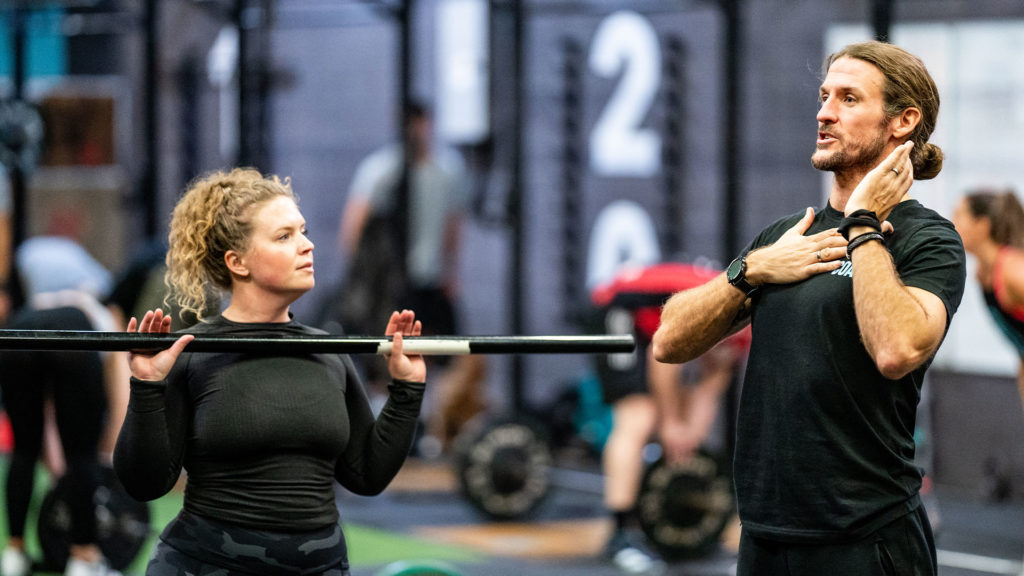
What is CrossFit?
At its core, CrossFit is a high-intensity fitness regime designed to build strength, endurance, and agility by combining various disciplines such as weightlifting, cardio, gymnastics, and bodyweight exercises.
The program is built around the idea of constantly varied, functional movements performed at high intensity.
All you have to do is Imagine a workout where you’re lifting weights one moment, then sprinting, then doing pull-ups—all within a timed setting with a coach motivating you throughout the session, often fostering a competitive yet supportive environment.
Overall, CrossFit’s aim is to prepare individuals for the unpredictable challenges of everyday life, from carrying groceries to running after children, by promoting overall physical readiness.
The Philosophy Behind CrossFit
CrossFit’s guiding principle is about pushing personal boundaries. Its philosophy is built on the notion that growth comes through discomfort—both physically and mentally.
In a typical CrossFit setting, individuals push past perceived limits, often motivated by the competitive energy of those around them.
Functional fitness is key to CrossFit’s ideology; the exercises are designed to enhance real-world movements.
The goal is not just to look fit but to become fit for life’s challenges.
The program cultivates mental resilience, as participants learn to push through fatigue and self-doubt, transforming themselves physically and mentally.
Benefits of CrossFit Training
Engaging in CrossFit offers numerous benefits, many of which extend beyond physical fitness:
- Strength: CrossFit enhances overall strength, enabling participants to tackle day-to-day activities with greater ease, from opening stubborn jars to carrying multiple grocery bags in one trip.
- Cardiovascular Health: The cardiovascular intensity of CrossFit is notable. Participants develop the ability to perform sprints and other aerobic exercises with increased stamina, though post-workout recovery may still be demanding.
- Flexibility and Mobility: CrossFit emphasizes a well-rounded approach to fitness, incorporating mobility and flexibility exercises to reduce the risk of injury and improve range of motion.
- Community and Camaraderie: Perhaps one of the most distinctive elements of CrossFit is the sense of community. Individuals often form strong bonds with fellow participants, celebrating each other’s successes and supporting one another through tough workouts. This creates a social environment that fosters accountability and motivation.
- Mental Toughness: CrossFit is not only a physical challenge but a mental one. Successfully completing workouts named after heroic figures or common routines (known as “WODs” or Workouts of the Day) like “Murph” or “Fran” instills a sense of accomplishment that transfers to other areas of life. The resilience built during CrossFit can help individuals better cope with external stressors, from work deadlines to personal challenges.
Common Misconceptions About CrossFit
- “CrossFit is dangerous!”
While CrossFit can involve intense movements, when performed with proper form and under trained supervision, the risk of injury is comparable to other physical activities. CrossFit gyms emphasize technique and scaling workouts to individual capabilities, ensuring participants develop safely. - “Everyone in CrossFit is already in shape.”
CrossFit is inclusive of all fitness levels. Whether you’re a beginner trying to get through your first session or a seasoned athlete aiming for personal records, CrossFit meets you where you are. The program is scalable, meaning the intensity and weight can be adjusted based on individual fitness levels. - “It’s a cult.”
While CrossFit may appear to have a tight-knit community, with its unique terminology and post-workout hangouts, it’s far from a cult. The camaraderie stems from shared challenges and mutual encouragement, and while the sense of belonging is strong, it is always a personal choice whether to engage in the broader social aspects. - “It’s too intense for me.”
The intensity of CrossFit can seem overwhelming, but every workout is adaptable. Participants are encouraged to move at their own pace, gradually increasing the intensity as their fitness improves. The competitive nature of CrossFit is balanced with individual goals and personal achievement. - “You need to consume endless protein shakes to do CrossFit.”
While nutrition is a critical component of fitness, CrossFit does not mandate an excessive intake of protein shakes. A well-balanced diet supports performance, but participants are free to choose how they refuel post-workout.
CrossFit is more than a workout; it’s a journey of physical and mental transformation.
While the intensity and variety of exercises may seem daunting at first, the supportive community and measurable progress make it a rewarding experience.
From mastering box jumps to surviving the infamous wall balls, CrossFit challenges the body and mind in equal measure. Whether you’re looking to gain strength, improve endurance, or simply test your limits, CrossFit provides an environment to do so.
Now, with chalk in hand and determination in heart, you’re ready to tackle your first WOD.
CROSSFIT METHODOLOGY
The CrossFit methodology is a structured yet dynamic approach to fitness, designed to challenge both body and mind through high-intensity, functional movements.
Rooted in the concept of training for the demands of everyday life, CrossFit combines a variety of exercises aimed at improving overall physical capacity, with an emphasis on strength, endurance, and flexibility. Each workout integrates movements that mimic real-life activities, performed at high intensity to optimize performance across multiple domains of fitness.
Whether it’s lifting, running, or performing body-weight movements, CrossFit ensures that participants are prepared for a wide range of physical challenges.
Key to its philosophy is the constant variation in workouts, ensuring that no two sessions are alike. This unpredictability not only keeps the body guessing but also fosters continuous improvement by pushing participants beyond their comfort zones.
Ultimately, CrossFit seeks to cultivate resilience and adaptability, whether for competitive athletes or individuals looking to improve their daily physical well-being.
The Functional Movements
At the core of CrossFit’s effectiveness are functional movements, exercises that replicate the physical actions we use in everyday life.
These multi-joint, compound movements engage multiple muscle groups, promoting balance, coordination, and overall strength. In CrossFit, movements like squats, deadlifts, and presses are central, as they mimic tasks such as lifting, standing, or carrying.
The importance of functional movements extends beyond the workout itself. By training the body to move in ways that are both natural and efficient, CrossFit enhances real-world physical preparedness.
This training philosophy creates athletes who are not only stronger but also more agile and capable of navigating the physical challenges of everyday life.
Constantly Varied Workouts
One of the hallmarks of CrossFit is its commitment to constant variation in training. This approach ensures that workouts remain unpredictable, preventing both physical and mental stagnation.
CrossFit utilizes a vast array of movements and equipment, ranging from bodyweight exercises to Olympic lifts and gymnastic movements, ensuring no two workouts are the same.
The diversity in exercise selection challenges the body’s ability to adapt, promoting continuous growth and avoiding plateaus in performance.
This method is particularly effective for improving overall fitness, as it targets multiple energy systems, fostering aerobic capacity, strength, flexibility, and coordination.
The varied nature of CrossFit workouts prevents the routine from becoming mundane, ensuring that each session presents new challenges and opportunities for growth.
High-Intensity Interval Training (HIIT)
Central to the CrossFit methodology is High-Intensity Interval Training (HIIT), a protocol designed to maximize the benefits of both strength and cardiovascular training in a short amount of time.
HIIT involves alternating between periods of intense activity and short recovery, pushing the body to perform at maximum capacity before allowing brief rest. This style of training is known for its ability to burn fat, build muscle, and improve endurance efficiently.
In the CrossFit context, HIIT is integrated seamlessly into daily workouts, often combining weightlifting, gymnastics, and cardio exercises in quick succession.
This intense, time-efficient method of training is highly effective for improving cardiovascular health, building lean muscle mass, and boosting metabolic function.
Despite the challenge, the short bursts of activity make these workouts approachable, even for beginners, while delivering powerful results.
Scalability: Adapting Workouts for All Levels
A defining feature of CrossFit is its scalability, allowing athletes of all levels to participate in the same workout by adjusting the load and intensity to suit individual capabilities.
Whether one is a beginner or a seasoned athlete, CrossFit offers a framework that meets each participant where they are. The workout of the day (WOD) remains the same, but modifications can be made to accommodate different fitness levels, ensuring inclusivity.
For example, a workout that includes pull-ups can be scaled to use resistance bands or ring rows for those still building strength.
Similarly, weightlifting movements can be adapted by reducing the load or complexity.
This emphasis on scalability ensures that CrossFit is accessible and challenging for everyone, fostering a community where individuals of all abilities can train together.
The Importance of Form and Technique
In CrossFit, emphasis is placed on mastering form and technique before increasing weight or intensity. Proper movement patterns are essential for both performance and injury prevention.
Whether performing a basic air squat or a complex Olympic lift, athletes are encouraged to prioritize form over speed or load.
CrossFit coaches play a critical role in teaching and reinforcing good technique, providing cues and adjustments to ensure safety and effectiveness.
By focusing on proper mechanics, CrossFit athletes build a strong foundation, reducing the risk of injury and ensuring that they can progress safely over time.
Mastery of form also translates to greater efficiency in movement, allowing athletes to perform exercises with more control and precision, ultimately improving their performance.
CrossFit is a comprehensive fitness methodology that combines functional movements, varied workouts, and high-intensity training to build strength, endurance, and adaptability.
With an emphasis on scalability and technique, CrossFit is accessible to individuals of all fitness levels, offering a pathway to improved health and physical preparedness. Through its innovative approach, CrossFit challenges the traditional notion of fitness, creating an environment where athletes push beyond their limits while fostering community and resilience.
Whether for daily life or athletic competition, CrossFit provides a holistic, disciplined, and challenging approach to fitness.
CROSSFIT WORKOUT COMPONENTS
CrossFit is a dynamic and multifaceted fitness approach designed to test your physical and mental endurance. Each session is a carefully structured journey, blending intensity with precision, and designed to push your body to new levels of performance. The following breakdown provides insight into the core components of CrossFit, ensuring you are prepared for both the demands and the rewards that come with this training methodology.
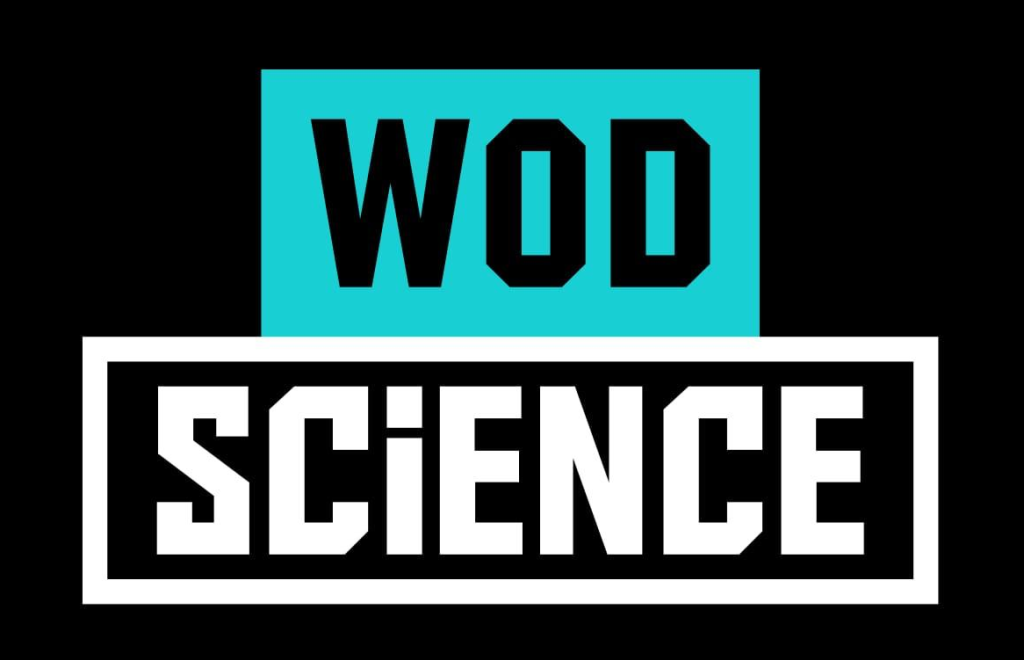
Warm-ups: Preparing for Peak Performance
In CrossFit, the warm-up is far more than a light jog or a few stretches; it is a strategic prelude to the workout that primes both the body and mind for the intensity to follow.
The warm-up is often a blend of bodyweight movements—air squats, lunges, bear crawls, and even burpees—that elevate your heart rate, lubricate your joints, and activate key muscle groups. This phase is crucial not only to prevent injury but also to prepare your body for the rigorous demands of the workout ahead.
In addition, it offers a moment to mentally focus and transition from daily stressors to the task at hand.
WOD (Workout of the Day): The Core Experience
The WOD represents the essence of CrossFit, serving as the central workout that varies from day to day.
This unpredictability is intentional, challenging your body to adapt to constantly shifting demands.
Whether it’s weightlifting, bodyweight movements, or endurance exercises, the WOD ensures that no two days are the same.
Workouts can range from short, high-intensity bursts like a 7-minute AMRAP (as many rounds as possible) to extended 30-minute endurance challenges.
The variety not only keeps participants engaged but also guarantees comprehensive fitness development, from strength to cardiovascular endurance.
Hero WODs: Honoring Sacrifice Through Endurance
Hero WODs are distinct in their purpose and intensity. Named in honor of fallen military and first responders, these workouts push athletes to their limits, mirroring the physical and mental perseverance of those who have made the ultimate sacrifice.
For instance, “Murph” – a Hero WOD – involves a mile run, 100 pull-ups, 200 push-ups, 300 squats, and another mile run, with the option to wear a weighted vest.
These workouts serve as a poignant reminder of sacrifice, encouraging athletes to push beyond perceived boundaries.
Metabolic Conditioning (MetCons): Building Endurance and Efficiency
Metabolic conditioning, or MetCons, is a defining feature of CrossFit, targeting your body’s energy systems to improve stamina, speed, and overall efficiency. These workouts are typically short but extremely intense, designed to keep your heart rate elevated for extended periods.
By combining movements such as rowing, kettlebell swings, and burpees, MetCons force the body to work at full capacity, burning calories while increasing aerobic and anaerobic endurance.
Though brief, these sessions are deceptively challenging, often leaving participants physically drained but significantly fitter over time.
Strength Training and Olympic Lifts: Cultivating Power and Precision
Strength training in CrossFit focuses heavily on Olympic lifts, such as the snatch and clean and jerk, which require both raw power and technical proficiency. These lifts, often incorporated into the WOD or performed in dedicated strength sessions, enhance your overall muscle strength, coordination, and explosive power.
The progressive nature of CrossFit’s strength training allows you to gradually increase the weights you lift, developing not only muscular endurance but also mental resilience as you master complex movements.
The sense of achievement that comes from successfully executing these lifts is unmatched, accompanied by the familiar clang of the barbell hitting the ground as you complete a heavy set.
Gymnastics Movements: Elevating Body Control and Mobility
CrossFit also integrates gymnastics movements, which foster body control, mobility, and core strength.
From handstand push-ups to muscle-ups, these exercises demand a combination of upper-body strength, balance, and coordination. Movements such as the kipping pull-up—unique to CrossFit—require mastery of momentum and technique, making them both physically and mentally challenging.
Over time, athletes develop the ability to perform advanced bodyweight exercises with efficiency and grace, unlocking new levels of fitness.
Cardiovascular Training: Endurance for Life’s Challenges
While strength training often takes the spotlight, cardiovascular conditioning is an equally critical component of CrossFit.
Whether running, rowing, or cycling, cardio workouts test your endurance and lung capacity, complementing the high-intensity efforts of other movements. The inclusion of cardio within a WOD keeps your overall fitness well-rounded, ensuring that you are as prepared to endure prolonged physical activity as you are to lift heavy objects.
CrossFit’s blend of cardio and strength develops a balanced, capable athlete who excels across multiple domains of fitness.
Cool Downs and Recovery: Essential for Longevity
After the intense physical exertion of a CrossFit session, the cool down is a critical yet often overlooked aspect of the workout. Stretching, foam rolling, and mobility work serve to lengthen tight muscles, improve flexibility, and accelerate recovery.
This phase also provides an opportunity to gradually bring your heart rate down, fostering a sense of calm and reflection post-workout.
Recovery is an integral part of the CrossFit ethos, recognizing that proper rest and rejuvenation are essential to sustaining long-term fitness and avoiding burnout or injury.
In conclusion, CrossFit’s structure—ranging from its warm-ups to cool downs—is a holistic approach that targets every facet of physical fitness. Each component is thoughtfully designed to build strength, endurance, flexibility, and mental resilience, making it a versatile and highly effective training regimen for anyone willing to embrace its challenges.
UNDERSTANDING CROSSFIT MOVEMENTS
Entering the realm of CrossFit introduces a unique lexicon of movements, each requiring a blend of strength, coordination, and determination. These foundational movements form the backbone of the CrossFit training methodology, demanding not only physical exertion but also mental focus as you refine your form and execution.
Let’s delve into the key movements, exploring the nuances that make CrossFit a comprehensive, high-intensity fitness regimen.
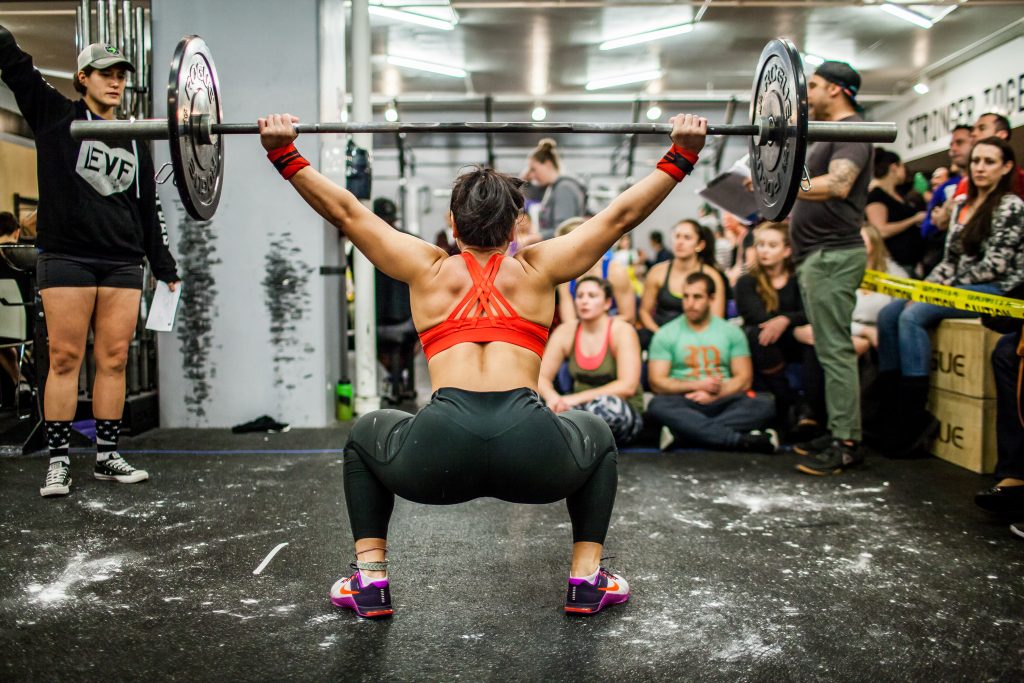
Squats: Air Squat, Front Squat, Overhead Squat
Squats are a cornerstone of CrossFit, essential to building lower body strength and stability. These movements may seem familiar at first, but CrossFit introduces variations that significantly elevate their difficulty and effectiveness.
- Air Squat: The simplest form of the squat, performed without additional weight, yet it is critical in developing foundational strength and mobility. Maintaining a strong, upright posture with heels grounded and chest elevated becomes crucial when performing numerous repetitions in a Workout of the Day (WOD), turning what seems like a basic movement into a full-body challenge.
- Front Squat: By positioning a barbell across your shoulders, the front squat engages your core more intensely. The high-elbow position requires thoracic mobility and balance, reinforcing posture while pushing your quadriceps and core to their limits. This movement is as much about stability as it is about power.
- Overhead Squat: One of the most technical movements in CrossFit, the overhead squat demands superior mobility, coordination, and strength. Holding a barbell overhead as you squat forces your shoulders, core, and hips to work in unison, testing your body’s ability to control a loaded barbell in a dynamically shifting position.
Deadlifts and Variations
The deadlift, a fundamental strength exercise, exemplifies functional fitness at its best—lifting a weight from the ground to standing. While it may seem straightforward, mastering the intricacies of form ensures both efficiency and safety.
- Deadlift: This classic movement engages the posterior chain—hamstrings, glutes, and back—by lifting a loaded barbell from the ground to the hip with a strong, neutral spine. Beyond the gym, this movement directly translates to daily tasks that involve lifting heavy objects.
- Sumo Deadlift High Pull: With a wide stance and a powerful upward pull, this variation emphasizes hip extension, back engagement, and upper body activation. The movement combines the force of a deadlift with a high pull, refining power generation through an explosive, full-body lift.
Presses: Shoulder Press, Push Press, Push Jerk
Pressing movements in CrossFit build shoulder strength and stability, with subtle differences in technique creating varied levels of intensity and power.
- Shoulder Press: A strict upper-body movement, the shoulder press isolates the deltoids and triceps, relying purely on arm and shoulder strength to press a barbell overhead. The absence of leg drive makes this one of the most challenging overhead presses.
- Push Press: Introducing a slight dip in the legs, the push press adds an element of momentum to help drive the barbell overhead. The legs initiate the movement, transferring force to the arms, thus allowing for heavier loads to be lifted compared to the shoulder press.
- Push Jerk: Involving both leg drive and a rapid drop under the bar, the push jerk enhances efficiency when lifting heavier weights. This dynamic movement allows athletes to lift significantly more weight than a standard press, as the bar is caught overhead while the body dips beneath it.
Olympic Lifts: Snatch and Clean & Jerk
Olympic lifting requires precision, speed, and explosive power. These complex movements are the epitome of athleticism, combining raw strength with coordination and timing.
- Snatch: In one continuous motion, the barbell moves from the floor to overhead, testing your ability to generate power and speed while maintaining control. The snatch is an artful blend of technical proficiency and strength, requiring full-body engagement from start to finish.
- Clean & Jerk: This two-part lift demands both technique and strength. The clean involves lifting the barbell from the ground to the shoulders, while the jerk drives it overhead. Both movements challenge your ability to transition between speed and control, making this one of the most respected Olympic lifts.
Gymnastics Skills: Pull-ups, Muscle-Ups, Handstand Push-Ups
Incorporating bodyweight gymnastics movements into CrossFit adds an element of athleticism that goes beyond lifting heavy weights. These skills build coordination, balance, and control over your body.
- Pull-ups: Beyond the strict pull-up, CrossFit introduces the kipping pull-up, which utilizes momentum from the hips and core to propel the body upward. The kip makes pull-ups more efficient during high-rep workouts, yet still demands considerable upper body and core strength.
- Muscle-Ups: A challenging progression from the pull-up, the muscle-up involves transitioning from hanging below the bar to pushing up above it. This compound movement integrates pulling strength with pressing ability, embodying the fusion of power and agility.
- Handstand Push-Ups: A true test of balance and strength, this movement requires athletes to press their body weight while inverted. Handstand push-ups target the shoulders and core while also demanding balance and spatial awareness.
Kettlebell Movements: Swings, Snatches, Turkish Get-Ups
Kettlebells are a versatile tool in CrossFit, providing dynamic movements that test strength, endurance, and coordination.
- Kettlebell Swings: A posterior chain exercise, the kettlebell swing develops power through the hips while engaging the core and upper body. The American swing (where the kettlebell is swung overhead) further increases the range of motion, challenging coordination and endurance.
- Kettlebell Snatch: Similar to the barbell snatch, the kettlebell snatch involves an explosive movement from below the hips to overhead, but with one hand. This movement builds unilateral strength and coordination, requiring precise control over the kettlebell’s path.
- Turkish Get-Up: This slow, methodical movement challenges mobility and stability as you move from a lying position to standing while holding a kettlebell overhead. It tests coordination, balance, and strength throughout the body, reinforcing joint stability and body awareness.
Bodyweight Movements: Burpees, Box Jumps, Push-Ups
CrossFit also emphasizes high-intensity bodyweight movements, which build endurance and functional strength without the need for equipment.
- Burpees: Combining a push-up and a jump, burpees are a full-body exercise that challenges both cardiovascular endurance and muscular stamina. This movement embodies the relentless, high-intensity spirit of CrossFit, demanding continuous effort over time.
- Box Jumps: Jumping onto a box from a standing position is a plyometric exercise that tests lower body power and coordination. As you progress, the height of the box increases, pushing your limits in explosive strength and agility.
- Push-Ups: Whether performed as strict or hand-release push-ups, this classic movement targets the chest, shoulders, and triceps, often becoming more challenging in the context of high-rep CrossFit workouts where fatigue is inevitable.
CrossFit movements are designed to challenge every aspect of your fitness, from strength and power to endurance and coordination.
Mastering these exercises requires patience, technique, and consistency, but the reward is a level of functional fitness that translates seamlessly into everyday life.
CROSSFIT EQUIPMENT
A deep dive into the essential CrossFit equipment reveals not just tools for strength and conditioning but instruments of precision, designed to sculpt both the body and the mind. Each piece serves a distinct purpose, playing a critical role in the holistic approach to fitness that CrossFit embodies.
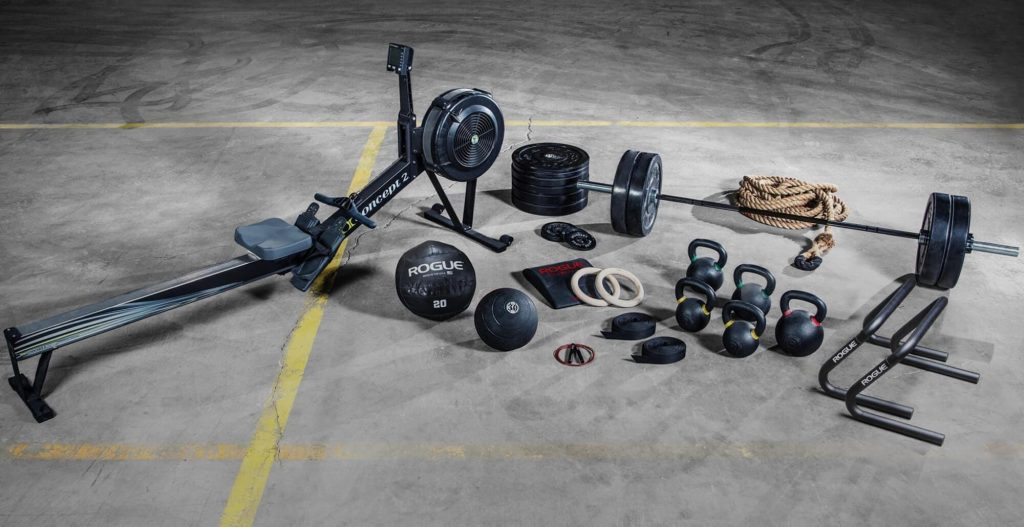
Barbells and Plates
The barbell, an iconic symbol of strength training, forms the foundation of CrossFit’s powerlifting and Olympic weightlifting components. Composed of tempered steel, barbells offer versatility, supporting movements ranging from deadlifts to snatches.
When loaded with plates, the barbell becomes a potent tool for developing functional strength, demanding impeccable technique to avoid injury. Every additional plate added to the bar is a silent challenge, compelling athletes to balance power with precision.
As an instrument of progressive overload, the barbell represents the relentless pursuit of improvement, requiring not only physical endurance but a strong mental fortitude to push beyond perceived limits.
Kettlebells
A deceptively simple tool, the kettlebell, with its cast iron design, introduces a dynamic element to CrossFit training.
Unlike static weights, kettlebells facilitate explosive movements such as swings, snatches, and cleans, challenging an athlete’s coordination, balance, and core stability.
The asymmetrical nature of kettlebell exercises activates more stabilizer muscles compared to traditional lifts, promoting a greater range of motion and functional strength.
In CrossFit, kettlebells are often used in high-rep circuits, pushing both muscular endurance and cardiovascular capacity to their limits.
Rowers, Assault Bikes, Ski Erg, and Curved Treadmills
Cardio equipment in CrossFit plays a unique role, not merely to improve endurance but to simulate real-world scenarios that demand functional fitness.
The rower is a quintessential tool for full-body cardiovascular conditioning, engaging over 85% of the body’s musculature in each stroke. Athletes must master the art of controlled breathing and efficient movement to maintain pace, especially in high-intensity workouts.
The Assault Bike, with its fan-resistance system, amplifies effort with each revolution, making it a formidable test of an athlete’s ability to maintain composure under fatigue. It’s often seen as a ruthless finisher in WODs, where mental endurance is tested as much as physical output.
The Ski Erg offers a complementary cardio challenge, simulating cross-country skiing movements. It engages the upper body in ways few other cardio machines do, emphasizing the lats, triceps, and core with each pull. The repetitive nature demands a strong cardiovascular system, but also control over technique, as form can easily degrade under exhaustion.
Lastly, the curved treadmill represents a biomechanically efficient method of running, replicating a natural stride pattern without the reliance on an electric motor. This self-propelled machine demands consistent effort, as the runner dictates their speed through body position and leg drive, encouraging proper running mechanics and reducing the impact forces seen in traditional treadmills.
Gymnastics Rings
Gymnastics rings in CrossFit provide a humbling experience for even the strongest athletes. These suspended tools challenge stabilizing muscles to the extreme, whether performing dips, muscle-ups, or holds.
Mastering the rings requires immense core strength, shoulder stability, and balance, transforming each movement into a complex integration of power and control.
Far from static exercises, ring work demands continuous adaptation, making it a dynamic test of both body awareness and strength-to-weight ratio.
Medicine Balls and Slam Balls
Medicine balls and slam balls introduce a dimension of functional power and explosive strength into CrossFit.
The weighted medicine ball, often used in wall ball exercises, requires athletes to merge strength and precision.
The repetitive cycle of squat, throw, and catch builds muscular endurance while simultaneously testing coordination.
On the other hand, slam balls, with their dead weight, are designed to absorb impact, making them ideal for explosive slams.
This motion engages the entire kinetic chain, forcing the core, shoulders, and lower body to work in unison while building rotational power.
Jump Ropes
In CrossFit, jump ropes transcend their childhood innocence and evolve into instruments of conditioning.
Whether executing double-unders or single-unders, jump rope training enhances cardiovascular endurance, foot speed, and coordination.
Double-unders, where the rope passes beneath the feet twice per jump, push the limits of timing, agility, and cardiovascular efficiency.
Mastery requires precision and a deep well of focus, as a misstep often results in the sting of failure—a reminder of the fine line between effort and mastery.
Explore top jump ropes and find your perfect fit!
Plyometric Boxes
Plyometric boxes represent the essence of explosive power and athleticism in CrossFit.
Box jumps challenge an athlete’s ability to generate force quickly, a key component of functional fitness.
The height of the box serves as a tangible metric of progress, while the repetitive nature of plyometric training builds power, speed, and resilience.
Each jump engages the quads, hamstrings, glutes, and calves, while also requiring a high level of coordination and mental focus to ensure accuracy and safety during landings.
Pull-up Bars and Rigs
The pull-up bar is a mainstay in CrossFit, facilitating a variety of gymnastic movements including kipping pull-ups, strict pull-ups, and muscle-ups. It represents the pinnacle of upper-body pulling strength, testing the endurance of the back, shoulders, and arms.
Athletes must hone their grip strength and core stability to excel, while the rig provides a structural hub for complex movements.
Beyond pull-ups, the rig supports dynamic exercises like toes-to-bar and bar muscle-ups, creating a multifaceted platform for upper body and core development.
CrossFit equipment goes far beyond mere objects for physical training.
Each piece introduces a unique challenge that builds not only physical strength but also resilience, adaptability, and discipline. Together, they form the backbone of a training system that pushes the boundaries of what it means to be truly fit.
CROSSFIT TRAINING PROGRAM
Delving into a CrossFit training program is a commitment to both physical and mental growth.
While the workouts themselves demand intensity, the journey offers a profound understanding of endurance, discipline, and community.
Whether you are a novice just starting or an elite athlete pushing the boundaries of human capability, each phase of CrossFit introduces distinct challenges and rewards.
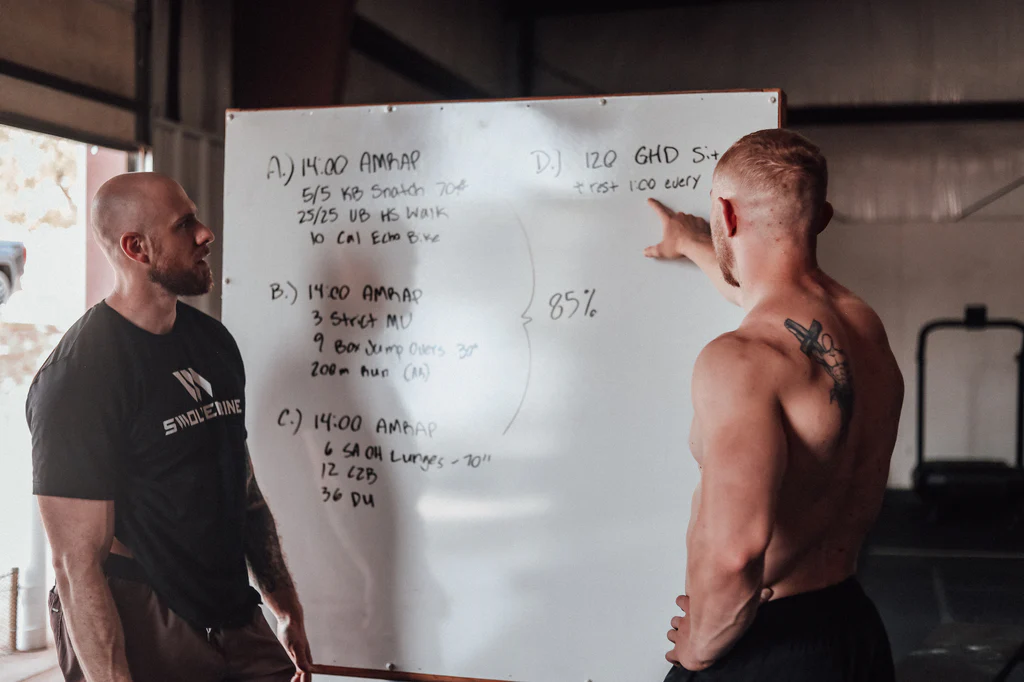
CrossFit for Beginners
Stepping into CrossFit for the first time can feel overwhelming, yet exhilarating.
As a beginner, you are introduced to fundamental movements that will form the foundation of your training.
Movements like squats, deadlifts, and box jumps may appear simple, but each brings a complex blend of form, coordination, and strength. It is here that you learn about “WODs” (Workouts of the Day) and begin to understand the delicate balance between power and precision.
The concept of “scaling” is introduced early on—a crucial tool for tailoring workouts to your ability, allowing you to grow progressively without injury or burnout.
It’s common to be challenged by burpees or kettlebell swings, exercises that test endurance and functional strength.
However, alongside the physical strain, you’ll quickly find that CrossFit’s unique camaraderie and community support keep you motivated and grounded.
Over time, as movements like “snatch” and “AMRAP” (As Many Reps As Possible) become part of your vocabulary, you’ll discover the deeper mental aspects of training: patience, persistence, and resilience.
Intermediate Training Programs
The intermediate stage of CrossFit represents a shift from learning the basics to mastering them.
At this level, athletes have developed a solid foundation in technique and can now focus on refining performance. The workouts become more dynamic, incorporating advanced movements like kipping pull-ups and double-unders.
With increased strength and confidence, the emphasis shifts to endurance and strategic pacing.
No longer just about survival, the challenge is now about sustaining high performance over longer, more complex WODs.
Benchmark workouts such as “Fran” or “Murph” become opportunities to test your progress, and weights that once seemed daunting are now lifted with measured control.
While the physical intensity increases, so does your awareness of form and efficiency, as maintaining technique becomes critical for avoiding injury.
This phase also introduces mental fortitude, as you begin to push past physical discomfort and learn to manage fatigue while maintaining focus.
Advanced Athlete Programs
Advanced CrossFit athletes operate at a level where fitness becomes a finely tuned balance of power, speed, and agility.
Workouts at this stage demand precision, as elite movements like muscle-ups, handstand walks, and complex Olympic lifts become routine. The ability to execute these movements with efficiency is a testament to years of disciplined training, where even the slightest miscalculation can affect performance.
At this level, the mental component is equally paramount.
Elite athletes possess a deep understanding of their own limits and know how to push them without compromising form. The focus shifts from general fitness to specialization—targeting weaknesses and refining specific skills to prepare for competitions.
Hero WODs and other high-intensity sessions are taken on not only as a test of physical strength but as a reflection of mental resilience, a mindset forged through consistent, focused effort.
CrossFit Competitions and the CrossFit Games
CrossFit competitions represent the pinnacle of performance in the sport, where athletes come together to test the boundaries of human capability.
Whether at a local box event or the prestigious CrossFit Games, the atmosphere is electric, with each competitor striving to prove their place among the fittest. Competitions are not just about strength or speed but also about strategy, mental toughness, and the ability to adapt to the unknown.
The CrossFit Games, in particular, challenge even the most seasoned athletes, featuring events that test every aspect of fitness: strength, endurance, skill, and mental fortitude.
Competitors might face a range of physical tasks, from swimming and weightlifting to running, cycling, or completing grueling obstacle courses. The athletes competing here are not just lifting barbells or running miles; they are pushing the limits of what the human body can endure, all while maintaining an extraordinary level of focus and composure under pressure.
CrossFit Open: Participating in the Global Community
The CrossFit Open is the sport’s annual test of global fitness, where athletes from every level participate in a worldwide competition.
For five consecutive weeks, a new WOD is released, and athletes have a set time to complete the workout and submit their scores. What makes the Open unique is that it brings together all levels of athletes—from novices to elite competitors—united in a shared experience.
For many, the Open is less about competing for the top spot and more about testing personal progress. It serves as a benchmark for growth, highlighting areas of strength and revealing areas for improvement.
Each workout challenges not just physical capacity but also mental resolve, as athletes push themselves harder than ever, often surpassing their own expectations. It is also a chance to feel connected to the global CrossFit community, knowing that millions of others are tackling the same workouts simultaneously, creating a sense of shared purpose and collective achievement.
This refined version maintains the essence of the CrossFit journey while emphasizing the sophistication of training principles, personal growth, and the intricate dynamics of competition and community within the CrossFit ecosystem.
CROSSFIT NUTRITION: ELEVATING PERFORMANCE THROUGH FUNCTIONAL FUELING
Welcome to CrossFit, where each WOD (Workout of the Day) challenges your mental and physical limits, testing your endurance, strength, and determination.
But the key to thriving in these intense workouts goes far beyond sheer willpower—your nutrition must be just as functional as your fitness regimen.
A well-rounded diet is the foundation that can transform an athlete’s performance, enhancing their ability to recover, build muscle, and conquer every WOD with precision and strength.

The Role of Nutrition in CrossFit Performance: Optimizing Potential
In CrossFit, nutrition is the silent force behind every PR (personal record) and every efficient movement.
It’s not just about performing well during an AMRAP (As Many Reps As Possible) or staying strong in an EMOM (Every Minute On the Minute) session; it’s about consistently nourishing your body to handle the demands of Olympic weightlifting, gymnastics, and metabolic conditioning.
The right nutrition enables athletes to push through fatigue, recover effectively, and show up day after day with the energy required to excel.
CrossFit requires you to draw on diverse physical skills, and without proper fuel, you may find yourself stalled—whether it’s during a snatch sequence or halfway through a 500m row.
By prioritizing nutrition, athletes create a solid foundation for strength and endurance, which is especially critical in a sport that demands such varied and high-intensity performance.
Paleo and Zone Diet in CrossFit: Choosing Your Nutritional Blueprint
Two of the most well-regarded dietary frameworks within the CrossFit community are the Paleo and Zone diets. Each offers a structured approach to eating that aligns with the intense physical demands of the sport, but they differ in their guiding philosophies and methods of implementation.
The Paleo Diet: Simplicity in Natural Eating
The Paleo diet, often referred to as the “caveman” approach, emphasizes consuming whole, unprocessed foods—meats, fish, vegetables, fruits, nuts, and seeds—while avoiding modern processed foods, grains, and dairy.
This diet mirrors the eating patterns of our hunter-gatherer ancestors, focusing on nutrient density and natural sources of energy.
Paleo athletes appreciate the diet’s emphasis on clean eating, as it reduces inflammation, improves digestion, and promotes overall health. Its high-protein and healthy-fat composition makes it ideal for those looking to build lean muscle and enhance recovery times.
The Zone Diet: Precision in Macronutrient Balance
In contrast, the Zone diet takes a more scientific approach to eating.
Athletes following this method carefully balance their intake of macronutrients—40% carbohydrates, 30% protein, and 30% fat—ensuring that each meal is optimized for both performance and recovery.
By controlling portions and macronutrient ratios, the Zone diet aims to regulate insulin levels, reduce inflammation, and provide a steady stream of energy.
This structured approach can help athletes fine-tune their nutrition to support peak performance and fat loss without sacrificing muscle mass.
Meal Planning for CrossFit Athletes: Strategic Fueling for Performance
To meet the intense demands of CrossFit training, athletes must be deliberate about what they eat.
A strategic meal plan can make the difference between simply surviving a workout and excelling in it.
Properly timed and nutritionally balanced meals will ensure that you have enough energy for your workouts while also promoting efficient recovery.
Breakfast: Building the Foundation for the Day
A nutrient-dense breakfast is essential for preparing the body for the rigors of training.
An ideal CrossFit breakfast could include eggs, avocado, and sweet potatoes, providing a balance of protein, fats, and carbohydrates to fuel morning workouts. This combination supports sustained energy levels and prepares the body for the physical challenges ahead.
Lunch: Refueling for Endurance
A mid-day meal should focus on replenishing glycogen stores and maintaining energy levels throughout the day.
Grilled chicken paired with quinoa and vegetables, drizzled with olive oil, provides a balanced mix of protein, carbohydrates, and healthy fats, ideal for recovery and maintaining peak cognitive function during the workday.
Dinner: Supporting Recovery and Muscle Repair
In the evening, focus on replenishing and rebuilding.
A meal of salmon with leafy greens and roasted root vegetables offers lean protein for muscle repair and a rich supply of micronutrients and antioxidants to combat inflammation. Including nutrient-rich foods like spinach or kale can further support recovery after a demanding WOD.
Snacks: Sustaining Energy Between Meals
Smart snacking can help maintain energy levels throughout the day.
Snacks such as almonds, beef jerky, or a protein shake provide quick sources of protein and healthy fats, ensuring that hunger doesn’t derail performance or recovery.
Hydration and Recovery: Essential for Endurance and Longevity
In CrossFit, the importance of hydration cannot be overstated.
Proper hydration aids in maintaining optimal body temperature, joint lubrication, and nutrient transport—all vital for sustaining high-intensity training.
Hydrate consistently throughout the day to avoid the negative effects of dehydration during training, such as muscle cramps and decreased performance.
Electrolyte Balance
Maintaining electrolyte balance is crucial for athletes who engage in strenuous activities.
Including electrolyte-rich fluids or supplements can help replenish the body after intense sweating and prevent fatigue or muscle weakness.
Recovery Strategies
Recovery is where the body adapts to training stress and builds resilience.
Foam rolling, stretching, and mobility work are essential for reducing muscle stiffness and preventing injury.
A post-WOD recovery meal rich in protein and carbohydrates supports muscle repair and replenishes glycogen stores, preparing you for the next challenge.
CrossFit athletes who prioritize nutrition, hydration, and recovery will set themselves up for success both inside and outside the gym.
Whether you choose to follow the Paleo or Zone diet, or develop a hybrid plan that works for your unique needs, the key is to view food as a powerful tool for optimizing performance and ensuring longevity in this demanding sport.
Fuel smart, recover well, and be ready for whatever tomorrow’s WOD brings.
CROSSFIT SAFETY AND INJURY PREVENTION: HOW TO SURVIVE ANOTHER DAY OF WODS WITHOUT BECOMING A HUMAN PRETZEL
Welcome to CrossFit, an arena where mental fortitude meets physical challenge in every Workout of the Day (WOD).
However, the true success of a CrossFit athlete isn’t merely in completing grueling workouts, but in doing so safely and sustainably.
To ensure that you keep thriving without succumbing to injury, it’s essential to prioritize proper form, recovery, and self-awareness during every session.
Let’s explore the vital elements of safety in CrossFit, so you can navigate the intense workouts without compromising your long-term health.
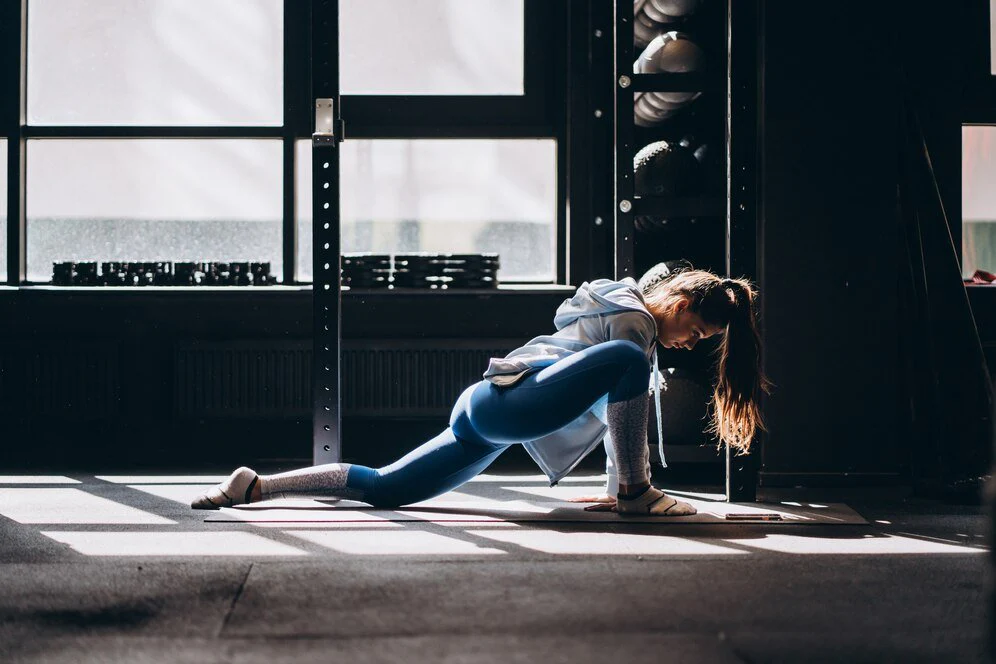
The Critical Role of Warm-Up and Cool-Down: A Non-Negotiable Routine
One of the most fundamental aspects of CrossFit injury prevention is a proper warm-up.
Your body is not designed to handle maximum loads or rapid movements without preparation. A thorough warm-up serves to increase blood flow, activate key muscle groups, and mentally prepare you for the challenge ahead.
Effective warm-ups should be dynamic, targeting areas that will be utilized during the workout.
Incorporating exercises like band work, dynamic stretches, or light cardio primes your joints and muscles for more strenuous activities, reducing the risk of strains and sprains.
Equally important is the cool-down phase.
After completing an intense workout, it’s essential to bring your heart rate down gradually and stretch the muscles you’ve just taxed. This helps to prevent stiffness and aids in the recovery process, ensuring you maintain flexibility and reduce soreness for future sessions. Skipping this step may lead to chronic tightness or overuse injuries that could impede your performance in the long run.
Prioritizing Technique: Form Over Reps
In CrossFit, mastering the technical elements of each movement is critical for both performance and safety.
Whether performing Olympic lifts, gymnastic skills, or functional movements, proper form ensures that you are engaging the right muscles and protecting your joints from undue stress.
Lifting Technique: When executing complex lifts like deadlifts, clean and jerks, or snatches, correct form is paramount.
For example, maintaining a neutral spine and engaging your core during deadlifts helps prevent lower back injuries, while proper foot positioning in squats protects your knees.
Prioritize controlled, precise movements over speed, especially when fatigue sets in during high-repetition WODs.
Pushing through poor form for the sake of completing the workout is a common path to injury.
Gymnastic Movements: Movements like kipping pull-ups and muscle-ups demand a high degree of control and shoulder stability. Poor execution can lead to shoulder impingements or rotator cuff injuries.
Consistent technique coaching, alongside mobility work, will ensure these movements are performed safely and efficiently.
Recognizing and Managing Injuries: Listen to Your Body
CrossFit often requires athletes to push beyond their comfort zone, but distinguishing between discomfort and pain is critical.
While muscle soreness and fatigue are normal by-products of intense training, sharp or localized pain should not be ignored. Ignoring these warning signs can lead to more serious injuries, such as ligament tears or tendonitis.
Common CrossFit Injuries: Shoulders, knees, and the lower back are the most vulnerable areas for CrossFit athletes. These regions endure significant strain during repetitive movements or heavy lifting.
If you experience pain in these areas, take the time to assess whether you need rest, modification of movements, or even medical attention.
It’s better to temporarily scale back than to push through and risk long-term damage.
Recovery Protocol: For minor strains or overuse issues, a combination of rest, ice, and rehabilitation exercises can be effective.
Consulting with a physical therapist or sports medicine professional can also provide targeted strategies for recovery.
The importance of rest cannot be overstated—it allows your body to repair and adapt, ensuring you come back stronger rather than more vulnerable to injury.
The Importance of Mobility and Flexibility: Ensuring Range of Motion
Mobility and flexibility are often overlooked but are integral to maintaining longevity in CrossFit. These factors allow your body to move efficiently and help prevent compensatory movement patterns that could lead to injury.
Joint mobility work, especially for the hips, shoulders, and ankles, should be incorporated into your routine to optimize movement mechanics during lifts and bodyweight exercises.
Mobility Work: Regular foam rolling, stretching, and mobility drills are essential for maintaining joint health and reducing tightness. These practices enhance your range of motion, allowing you to perform complex movements like overhead squats or pistols with proper alignment.
Neglecting mobility can lead to compensatory movements, which place unnecessary stress on joints and soft tissue, increasing the risk of injury.
CrossFit Safety Gear: Enhancing Performance with Protection
The right equipment can add an extra layer of protection during demanding workouts.
Safety gear, when used appropriately, enhances your performance and protects against injury without replacing proper form.
Weightlifting Belts: While weightlifting belts provide crucial support to the lower back during heavy lifts, they should complement—not replace—good lifting mechanics. Use them during max effort lifts or high-volume sets but ensure your core muscles are doing the bulk of the stabilization work.
Knee and Wrist Wraps: These accessories provide additional stability to joints under strain, such as during heavy squats or Olympic lifts.
Wraps can protect against hyperextension or excess movement in joints, offering a secure foundation when lifting substantial weight.
Footwear: The shoes you wear during CrossFit workouts can impact your performance and safety.
Weightlifting shoes provide a solid, stable base for lifts, improving your posture and balance.
Meanwhile, versatile CrossFit shoes are designed to handle the varied demands of a typical WOD, offering the necessary traction and support for lifting, running, and jumping.
Cultivating a Mindset of Longevity
While CrossFit challenges you to push beyond physical and mental boundaries, longevity should be the guiding principle of your training.
Incorporating deliberate warm-ups, focusing on correct technique, and using recovery and mobility tools will protect your body from unnecessary strain and injury.
Injuries may be part of any athletic endeavor, but they don’t have to define your CrossFit journey.
By being proactive and mindful of your body’s limits, you ensure not only your survival but continued success in the WODs ahead.
CROSSFIT BOX CULTURE: WELCOME TO THE LAND OF SWEAT, CHALK, AND HIGH FIVES
The CrossFit Box is a distinct fitness environment that defies the conventional expectations of a gym.
Rather than a space filled with treadmills and mirrors, it embodies a raw and minimalist ethos designed for functional fitness.
Envision a converted warehouse, with an industrial aesthetic marked by ropes suspended from the ceiling, barbells strewn about, and pull-up rigs that evoke the ingenuity of experimental design.
Here, the focus is on intensity, community, and personal growth rather than mere aesthetic presentation.
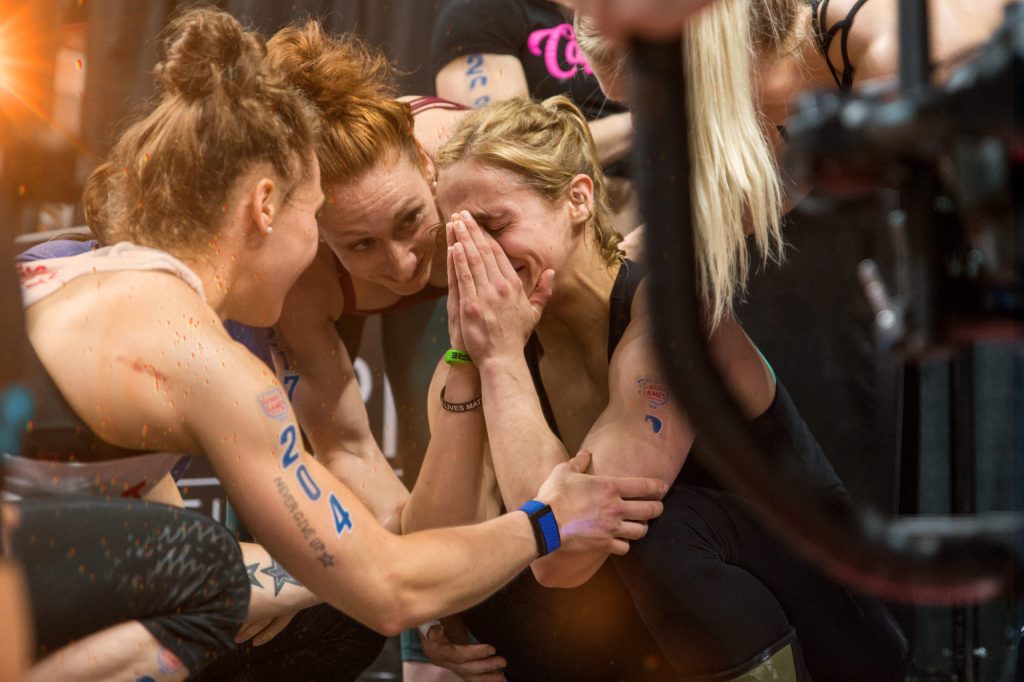
What is a CrossFit Box? (Hint: It’s Not a Storage Unit)
A CrossFit Box transcends the typical notion of a gym.
While standard fitness centers often prioritize polished machines and an environment that discourages visible exertion, a CrossFit Box is intentionally designed to cultivate a spirit of determination and resilience. It serves as a haven for those committed to pushing their physical boundaries.
The absence of mirrors encourages participants to focus on their performance rather than their appearance, fostering an atmosphere of genuine effort and personal challenge.
Community and Accountability: More Than Just People You Sweat With
Upon entering a CrossFit Box, one quickly realizes that it is not merely a venue for individual workouts; it is a vibrant community.
This collective spirit distinguishes CrossFit from conventional gyms, where interactions are often minimal. Here, individuals share their fitness journeys, celebrate each other’s milestones, and provide encouragement through each challenging workout.
The sense of accountability is palpable.
It is common for fellow members or coaches to reach out if someone misses a session, fostering a supportive environment that motivates individuals to remain engaged in their fitness pursuits.
This dynamic creates a network of mutual encouragement, transforming the often solitary experience of exercise into a collective effort toward shared goals.
CrossFit Coaches and Certifications: Your Friendly Neighborhood Fitness Experts
At the heart of each CrossFit Box is a dedicated team of coaches, akin to fitness experts who guide participants through their journeys.
These coaches are not merely trainers; they are mentors who understand the intricacies of movement and the importance of technique.
Their varied styles range from tough love to encouraging support, but all share a common goal: to enhance each individual’s performance while prioritizing safety and well-being.
CrossFit coaches undergo a comprehensive certification process, beginning with the Level 1 course, which equips them with essential skills and knowledge. Many go on to attain higher certifications, reflecting their deep understanding of the methodology and their commitment to ongoing education.
This ensures that participants receive quality instruction tailored to their needs, whether mastering a pull-up or learning to deadlift safely.
How to Choose the Right CrossFit Box: It’s Like Finding a Fitness Soulmate
Embarking on your CrossFit journey necessitates careful consideration of the Box that aligns with your values and goals.
Selecting the right environment is akin to finding a compatible partner, as each Box possesses its unique culture and approach to fitness.
Vibe Check: Each Box exudes a distinct atmosphere, from intensely competitive to warmly communal.
Consider whether you thrive in an environment driven by competition or one that emphasizes camaraderie and inclusiveness.
Attend trial classes to gauge the vibe and determine where you feel most comfortable.
Coaching Quality: The caliber of coaching can significantly impact your experience.
Seek coaches who prioritize proper form and technique over sheer volume of reps.
Engage with trainers who offer constructive feedback and personalized guidance, ensuring a safe and effective workout.
Programming: Different Boxes offer varied programming philosophies.
Some may emphasize strength development, while others might focus on conditioning.
Ensure that the programming aligns with your individual fitness objectives, whether you aim to enhance strength, cardiovascular endurance, or overall health.
Community: A supportive community enhances the CrossFit experience.
Look for a Box that fosters a sense of belonging, where members engage in celebratory high-fives and support one another during challenging workouts.
Participation in social events, such as post-workout gatherings, can further strengthen these bonds.
Facilities: While luxury amenities are not a hallmark of CrossFit Boxes, the availability of well-maintained equipment and an organized space is essential.
A clean environment, equipped with diverse tools for strength training and conditioning, is crucial for an enjoyable and productive workout.
The Box Life Is the Good Life
Choosing the right CrossFit Box represents a commitment to personal growth and community engagement.
In this environment, individuals are encouraged to push their limits, celebrate their progress, and support one another through the challenges of fitness.
The pursuit of excellence within a CrossFit Box transforms individual struggle into collective strength, creating a unique and rewarding fitness journey. Here, the shared experience of striving for improvement fosters lasting friendships and a profound sense of achievement.
CROSSFIT GEAR AND APPAREL: BECAUSE YOU CAN’T PR IN A PAIR OF FLIP-FLOPS!
CrossFit is where strength and endurance come together in an unparalleled fitness experience.
As you prepare to push your limits and achieve personal records, it’s essential to equip yourself with the right gear.
This guide to CrossFit essentials is designed to ensure you’re both prepared and well-equipped for the demands of your workouts.
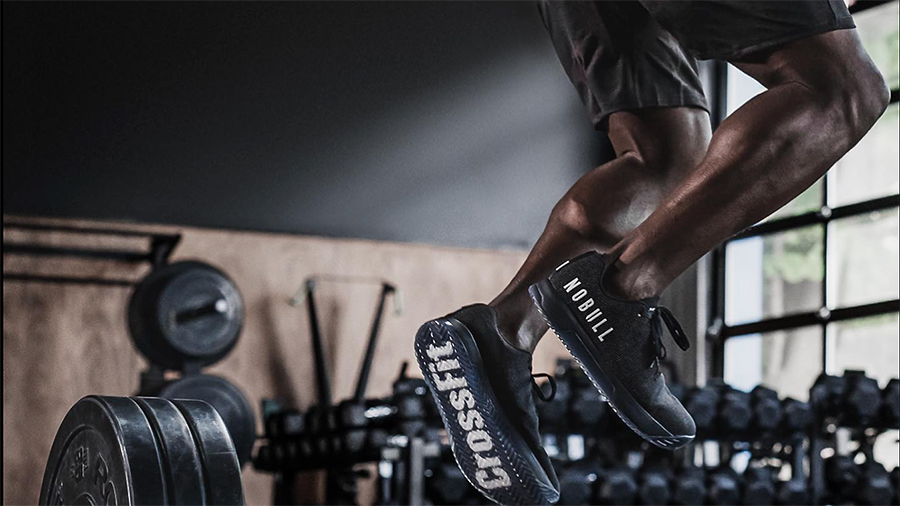
Choosing the Right Shoes for CrossFit: Function Meets Form
Your regular running shoes might serve you well during casual jogs, but they are insufficient for the diverse movements required in CrossFit.
Proper footwear is crucial; it must support a variety of activities, from weightlifting to high-intensity interval training.
When selecting CrossFit shoes, look for features that enhance performance.
Opt for a flat sole to provide stability during lifts, while ensuring the upper material offers flexibility and breathability for agility-based movements.
Style also plays a role; your footwear should reflect your commitment to fitness while making a statement.
The right pair will not only enhance your performance but also instill confidence in your capabilities.
Apparel for Performance and Comfort: Elevating Your Workout Experience
Choosing the right clothing is paramount to maximizing your performance and comfort during workouts.
Your attire should withstand the rigors of a full WOD (Workout of the Day) while allowing for a smooth transition to post-workout activities.
Shorts/Tights: Select shorts that provide adequate coverage for mobility without compromising modesty.
For women, high-performance tights are ideal, offering support and flexibility while accentuating your hard-earned physique.
Prioritize moisture-wicking fabrics that prevent chafing and keep you comfortable throughout your session.
Tops: Tank tops are a practical choice for showcasing your physique and facilitating movement.
Sleeves may be optional during vigorous activity, but layering is essential for cooler weather.
A quality hoodie or jacket can provide warmth during warm-ups but should be removed to prevent overheating during intense workouts.
Socks: Knee-high socks serve multiple purposes: they protect your shins during lifts and rope climbs while also allowing you to express your individuality.
Choose designs that resonate with your personality, whether subtle or bold.
Support Gear: Protecting Your Joints and Enhancing Performance
CrossFit can take a toll on your body, particularly on your joints.
Investing in supportive gear can help mitigate the risk of injury while enabling you to perform at your best.
Wrist Wraps: When lifting heavy, wrist wraps provide essential support, stabilizing your wrists and improving your lifting mechanics. They also convey a sense of dedication and professionalism.
Knee Sleeves: Knee sleeves are invaluable for athletes aiming to enhance their squat performance or endure repetitive movements. They provide warmth and compression, promoting blood flow and reducing the risk of strain.
Grips: Protecting your hands is crucial, especially during high-rep workouts. Grips can improve your ability to maintain a secure hold on the bar, leading to increased performance and reduced discomfort.
Chalk, Tape, and Other Accessories: Enhancing Your Performance
Chalk is an indispensable tool in the CrossFit arsenal, providing grip during lifts and bodyweight movements. It helps prevent slipping and maintains control, ensuring you can focus on your performance.
Athletic Tape: Athletic tape is essential for various applications, including protecting the hands during dynamic movements and assisting in recovery. It can also be used for stabilizing joints or supporting specific grips, adding versatility to your toolkit.
Additional Accessories: Consider incorporating other tools into your routine, such as foam rollers for recovery and shaker bottles for post-workout nutrition. These items enhance your experience but should be used judiciously to avoid overaccumulation of gear.
CrossFit Gear as a Reflection of Commitment
The gear you choose for CrossFit is more than mere functionality; it represents your dedication to the sport and your commitment to personal growth.
Each piece of equipment tells a story about your approach to fitness, reflecting both your capabilities and aspirations.
Ultimately, while quality gear is important, the core of your success lies within the community, the effort you invest in your training, and perhaps a touch of chalk for that extra grip.
Embrace the journey and express yourself through your gear, knowing that each workout brings you closer to your goals.
CONCLUSION: THE FUTURE OF CROSSFIT
As we look toward the future, it is evident that CrossFit has established itself as a mainstay in the fitness landscape, firmly rooted in the culture of athleticism and community.
Unlike fleeting trends, CrossFit continues to evolve, attracting individuals eager to embrace its dynamic approach to fitness.
The coming years promise to be transformative, as more enthusiasts discover the empowerment that comes from pushing their physical limits and engaging in high-intensity training.
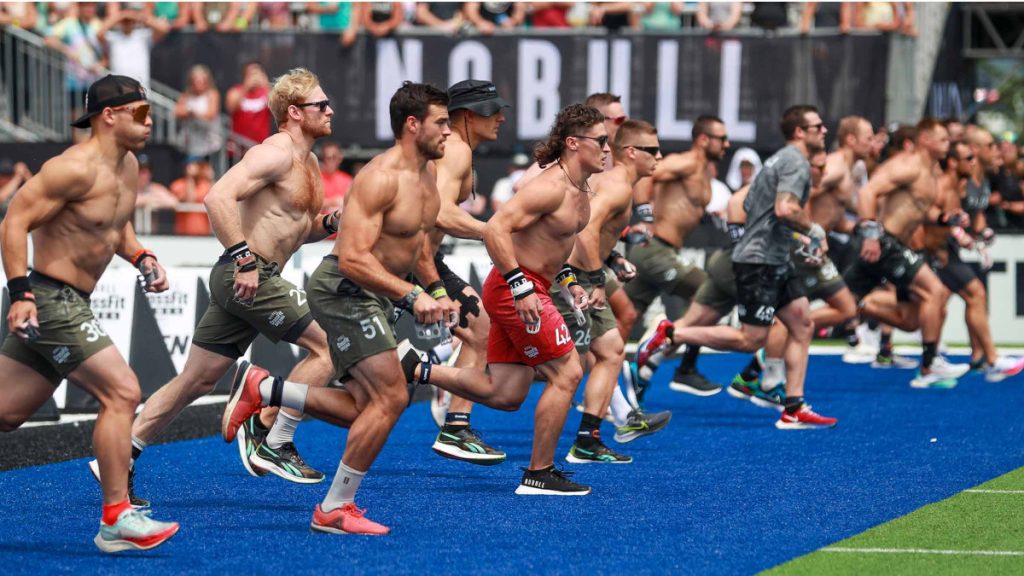
How to Maintain Long-Term CrossFit Success
Sustaining success in CrossFit over the long term is akin to nurturing a delicate ecosystem; it requires consistent care and attention.
The cornerstone of this journey is consistency.
Establish a structured training schedule that encourages regular attendance, even amidst the distractions of daily life. Just as brushing your teeth is a non-negotiable routine, so too should your commitment to CrossFit become a fundamental aspect of your lifestyle.
Incorporate Variety: Introduce diversity into your workouts to keep motivation levels high.
Explore new training modalities, alter your favorite movements, and consider integrating complementary activities like yoga or dance. This exploration not only keeps workouts fresh but also enhances overall fitness and resilience.
Nourish Your Body: Nutrition is a critical component of your CrossFit journey.
Embrace a philosophy centered around whole foods, lean proteins, and a variety of vegetables to fuel your workouts.
A well-balanced diet not only supports optimal performance but also promotes recovery, enabling you to engage fully in every session.
Set Meaningful Goals: Establishing clear and attainable goals is vital for maintaining focus and direction.
Utilize the S.M.A.R.T. framework—ensuring your objectives are Specific, Measurable, Achievable, Relevant, and Time-bound. This approach transforms vague aspirations into actionable targets, guiding your progress and fostering a sense of achievement.
CrossFit as a Lifestyle: Fitness Beyond the Box
CrossFit transcends mere physical training; it represents a holistic lifestyle that encompasses a supportive community and a shared commitment to health and well-being.
By engaging with CrossFit, you become part of a dynamic network of individuals who prioritize fitness as an integral part of their lives.
The Community Connection: There is a unique camaraderie that develops among individuals who work side by side in pursuit of common goals.
The relationships formed in the box often extend beyond the gym, creating a social fabric that includes shared experiences, encouragement, and mutual support.
The bonds forged during intense workouts foster a sense of belonging and community that enriches the overall experience.
The Mental Game: Beyond physical endurance, CrossFit cultivates mental resilience.
The challenges faced within the gym translate to greater tenacity in everyday life.
The grit developed while confronting a formidable workout prepares you to tackle obstacles outside the box with confidence and determination. This mental fortitude can empower you to approach life’s challenges with a renewed sense of purpose.
In summary, the future of CrossFit is promising and full of potential.
By committing to a long-term journey, prioritizing nutritional health, and embracing the lifestyle, you can optimize your fitness experience and foster meaningful connections.
Prepare yourself for the exciting path ahead—one characterized by growth, resilience, and the shared pursuit of excellence within the CrossFit community.
So lace up your shoes, embrace the spirit of camaraderie, and get ready to embark on this transformative journey, one workout at a time.
